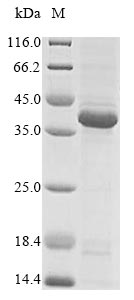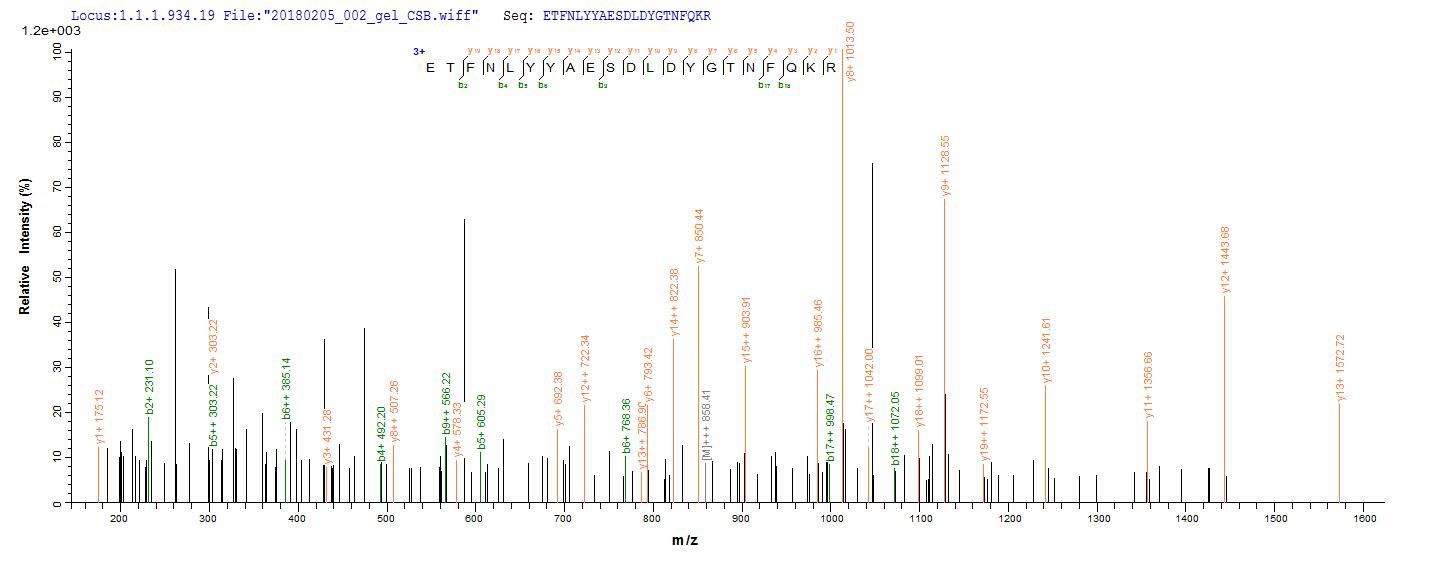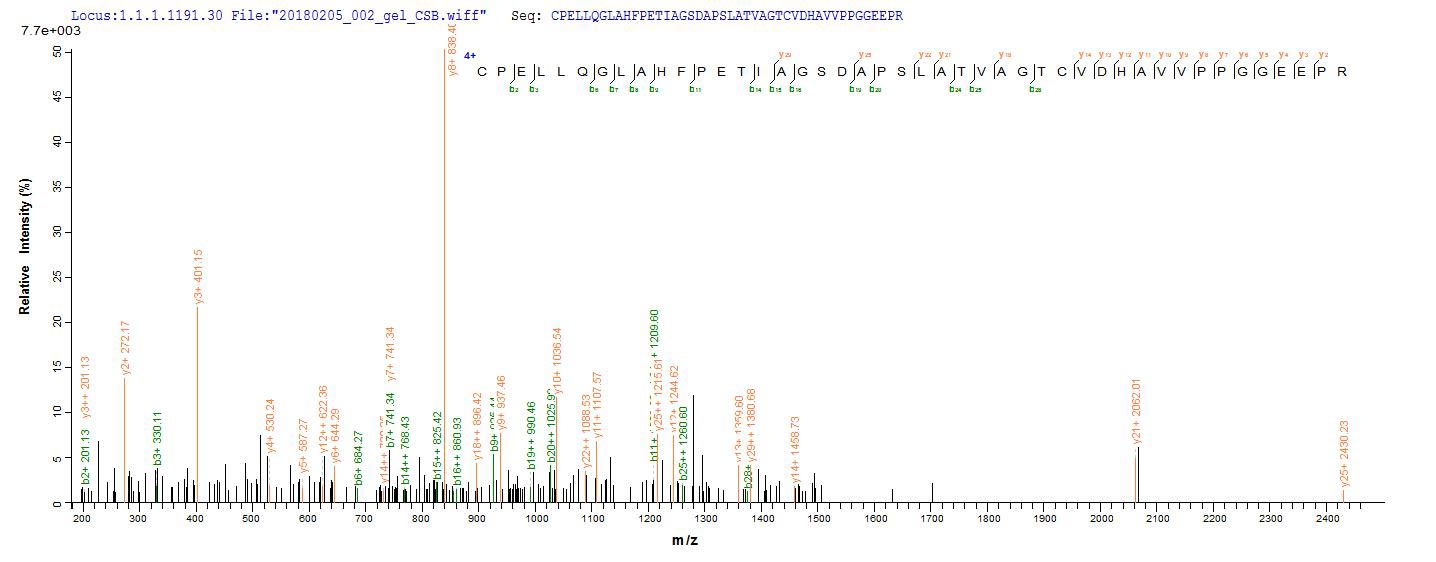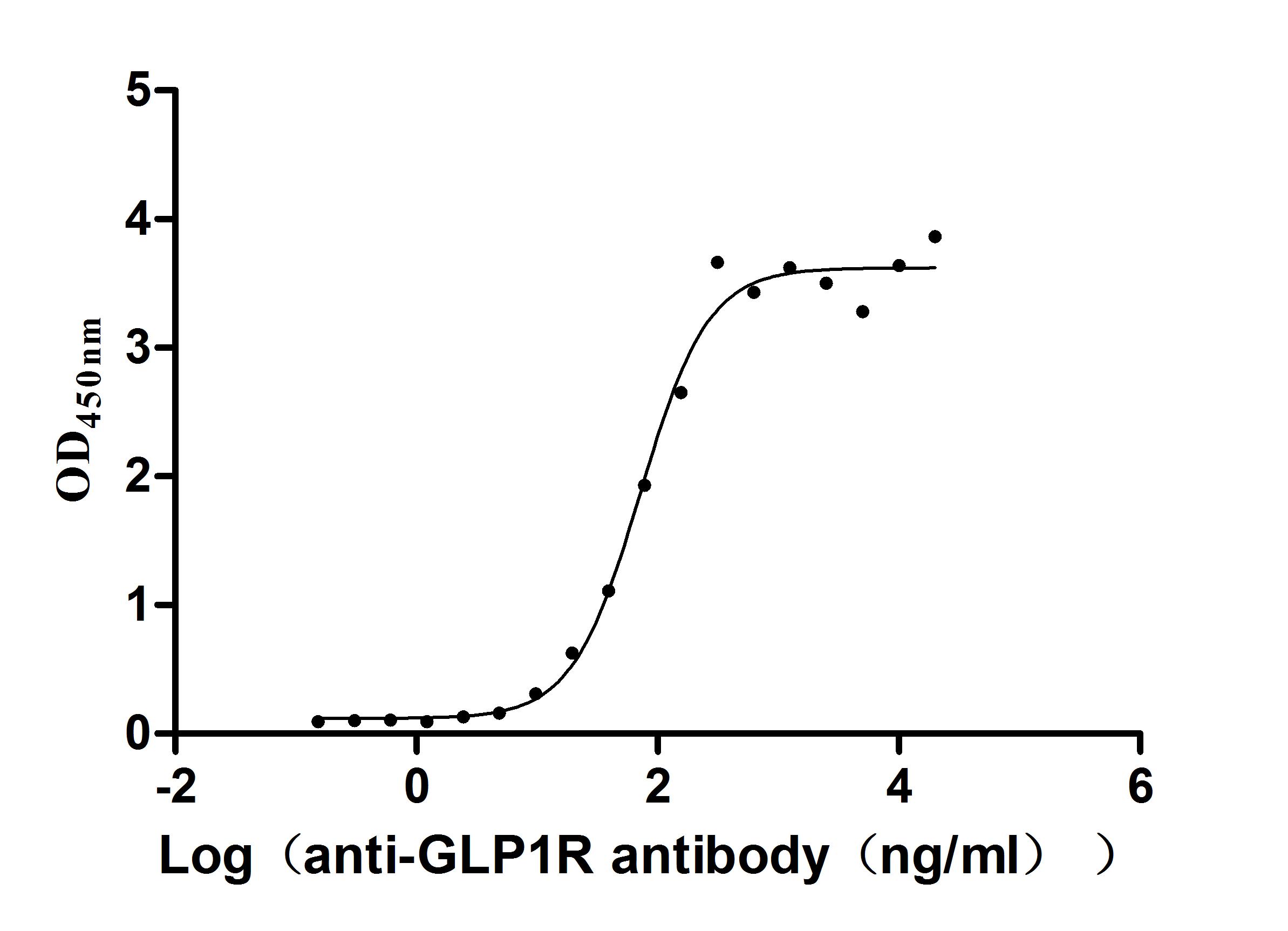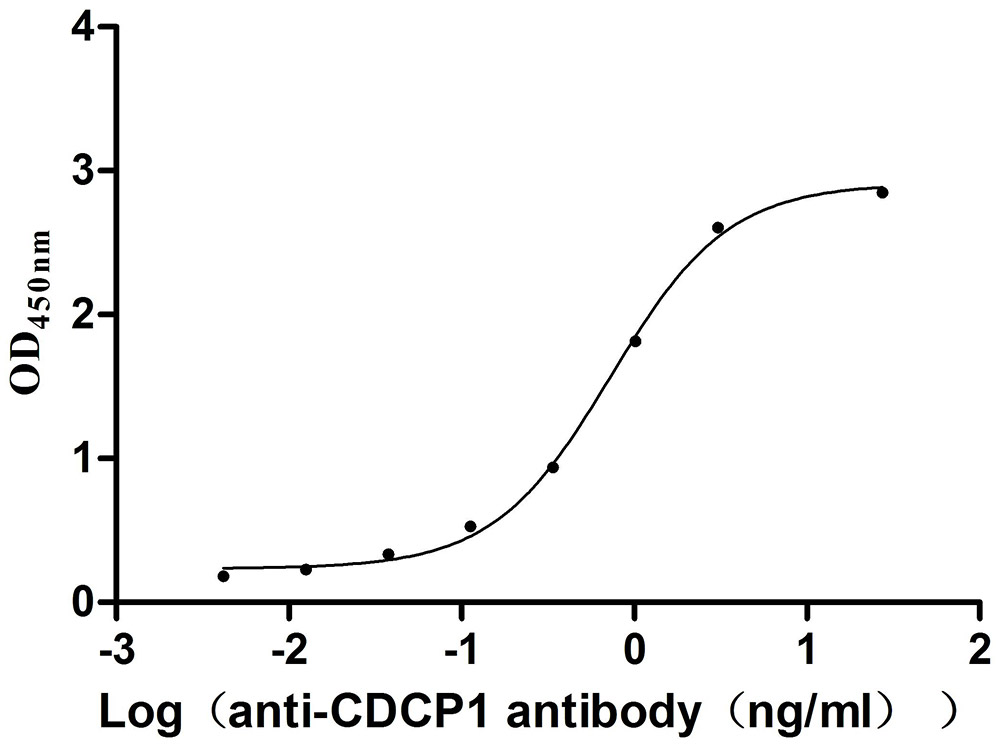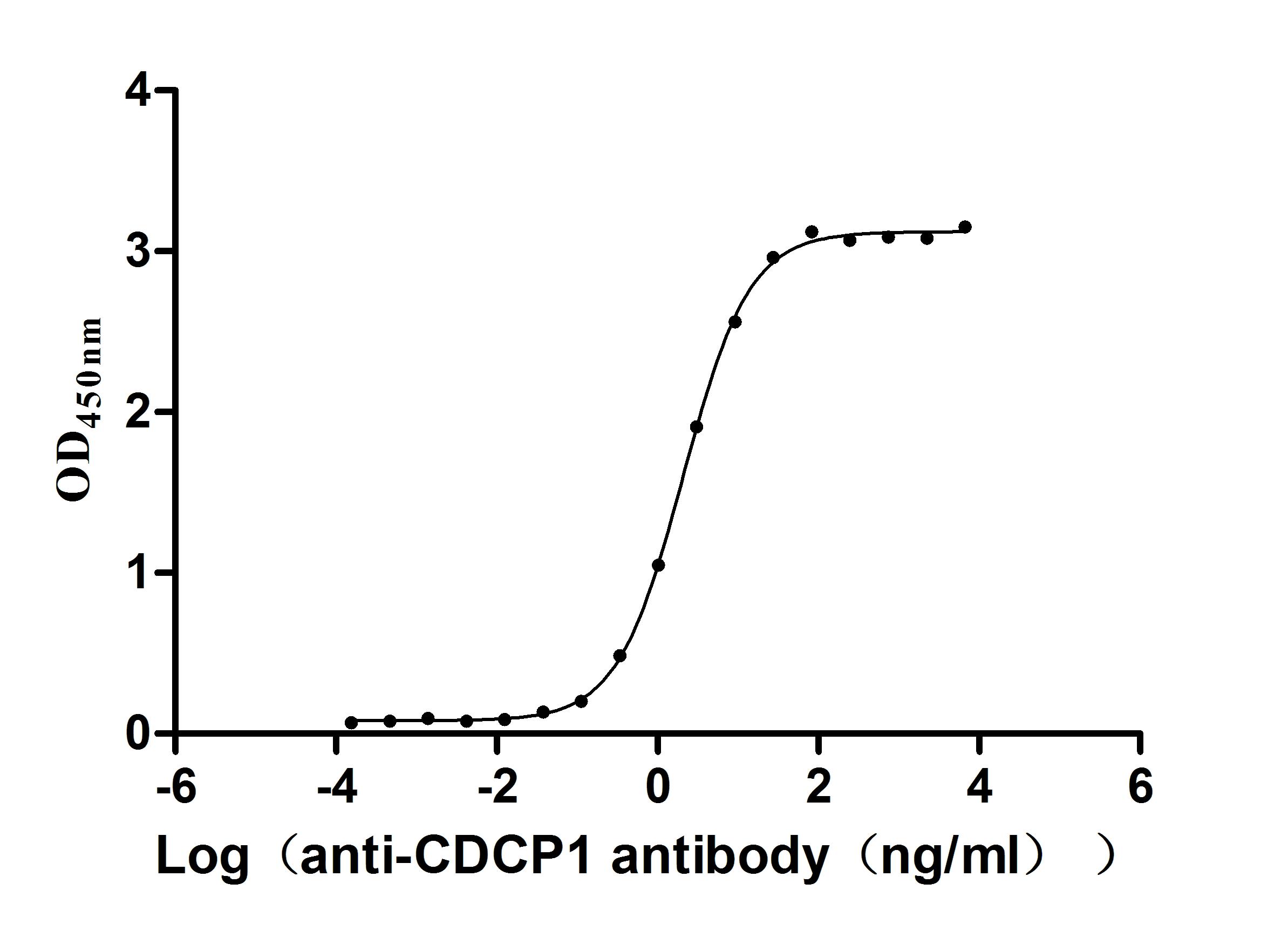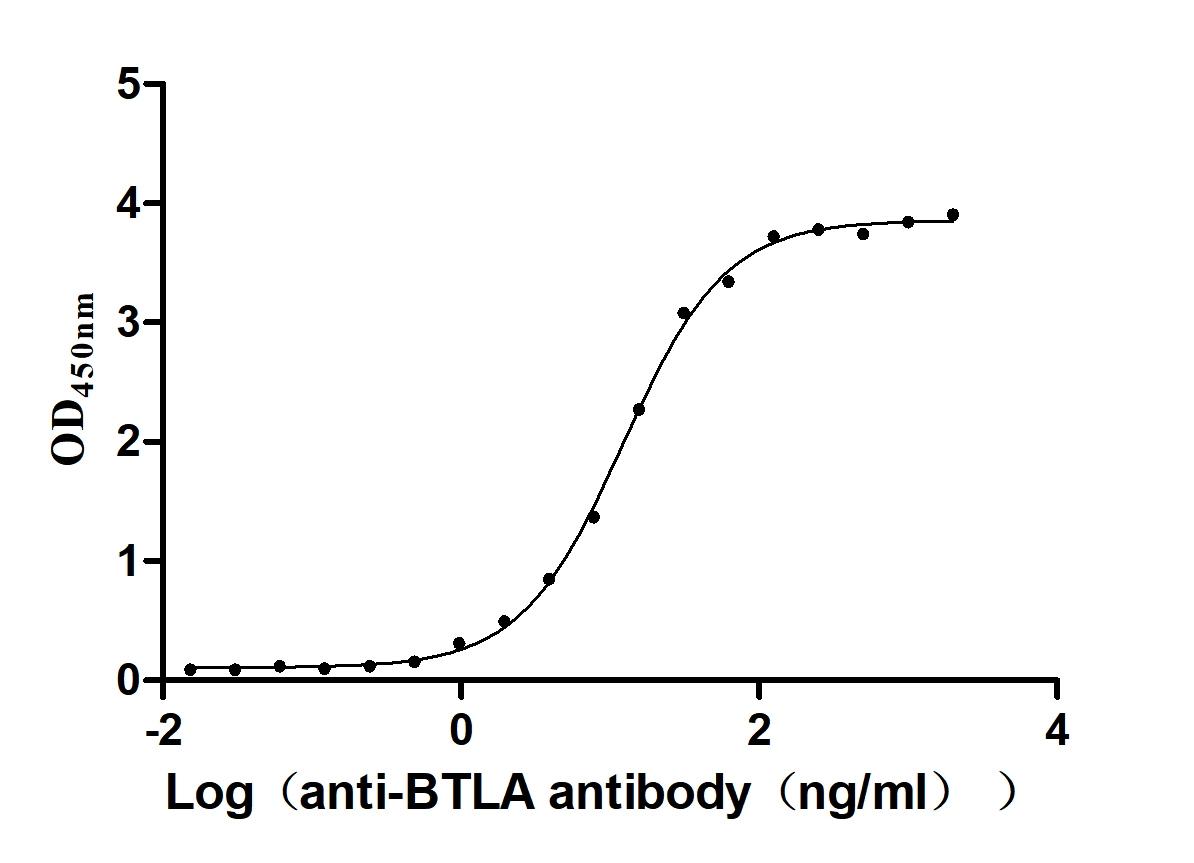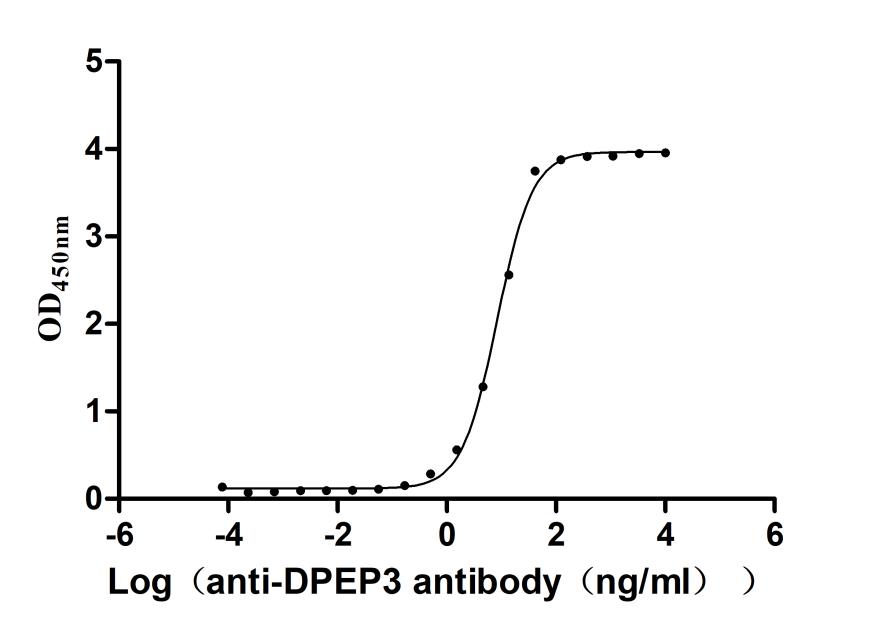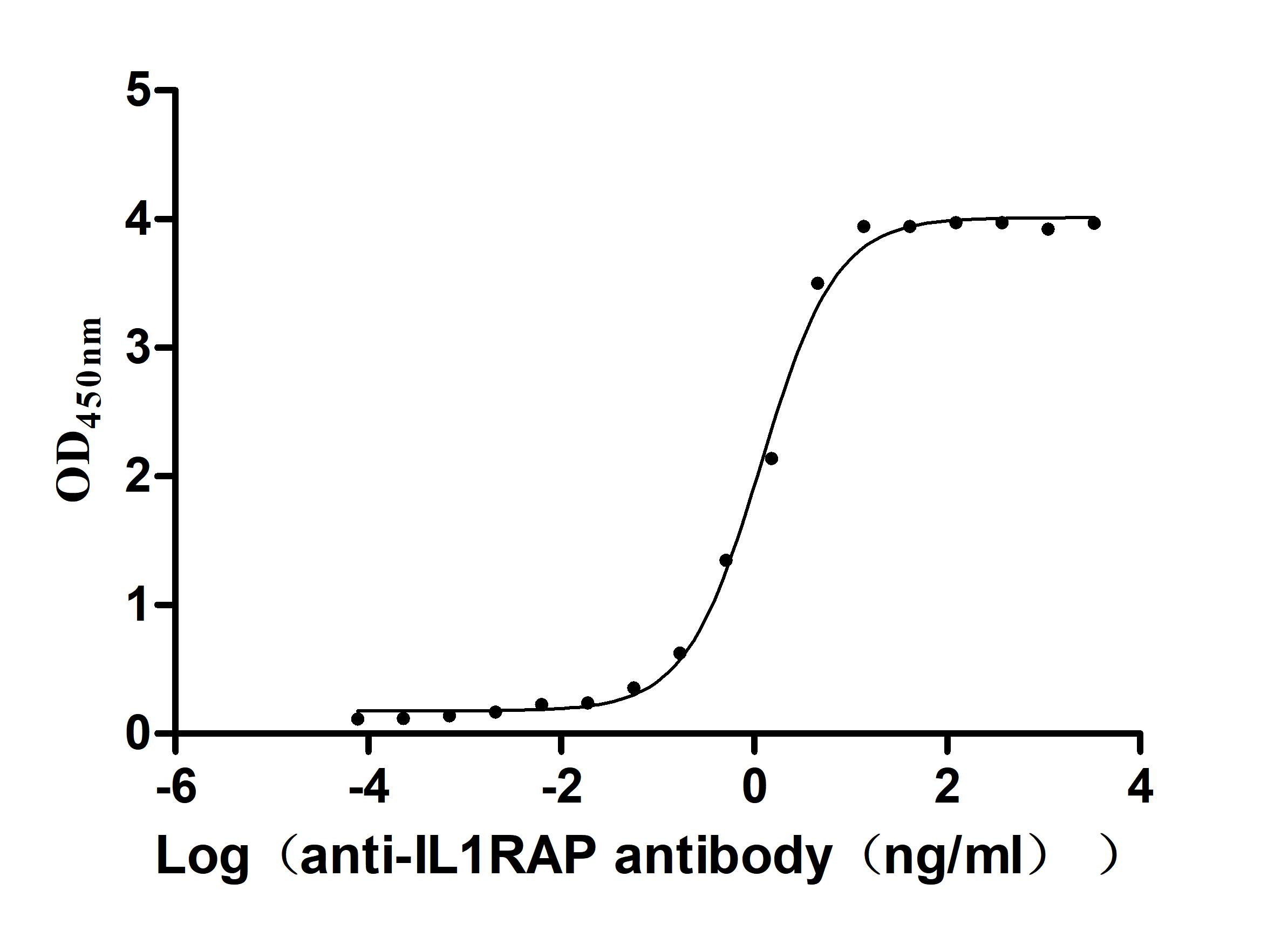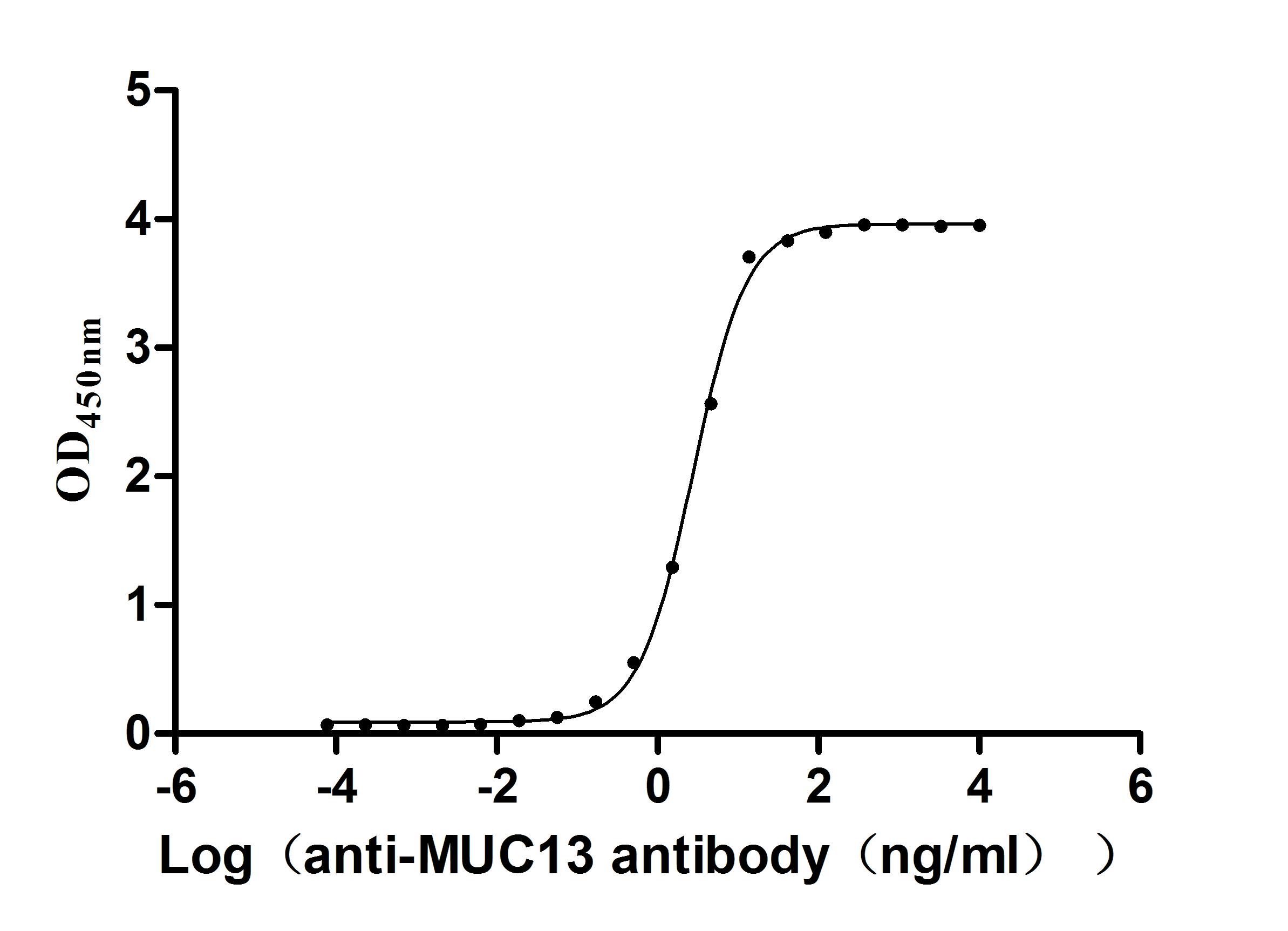Recombinant Human Ephrin type-A receptor 2 (EPHA2), partial
In Stock-
中文名稱:人EPHA2重組蛋白
-
貨號:CSB-EP007722HU1
-
規格:¥2328
-
圖片:
-
(Tris-Glycine gel) Discontinuous SDS-PAGE (reduced) with 5% enrichment gel and 15% separation gel.
-
Based on the SEQUEST from database of E.coli host and target protein, the LC-MS/MS Analysis result of CSB-EP007722HU1 could indicate that this peptide derived from E.coli-expressed Homo sapiens (Human) EPHA2.
-
Based on the SEQUEST from database of E.coli host and target protein, the LC-MS/MS Analysis result of CSB-EP007722HU1 could indicate that this peptide derived from E.coli-expressed Homo sapiens (Human) EPHA2.
-
-
其他:
產品詳情
-
純度:Greater than 85% as determined by SDS-PAGE.
-
基因名:
-
Uniprot No.:
-
別名:ARCC2; AW545284; CTPA; CTPP1; CTRCT6; EC 2.7.10.1; Eck; Eph receptor A2; EPHA2; EPHA2_HUMAN; Ephrin receptor ; Ephrin receptor EphA2; Ephrin type A receptor 2; Ephrin type-A receptor 2; Epithelial cell kinase; Epithelial cell receptor protein tyrosine kinase; Myk 2; Myk2; Sek 2; Sek2; Soluble EPHA2 variant 1; Tyrosine protein kinase receptor ECK; Tyrosine-protein kinase receptor ECK; Tyrosine-protein kinase receptor MPK-5; Tyrosine-protein kinase receptor SEK-2
-
種屬:Homo sapiens (Human)
-
蛋白長度:Partial
-
來源:E.coli
-
分子量:38.3 kDa
-
表達區域:28-328aa
-
氨基酸序列EVVLLDFAAAGGELGWLTHPYGKGWDLMQNIMNDMPIYMYSVCNVMSGDQDNWLRTNWVYRGEAERIFIELKFTVRDCNSFPGGASSCKETFNLYYAESDLDYGTNFQKRLFTKIDTIAPDEITVSSDFEARHVKLNVEERSVGPLTRKGFYLAFQDIGACVALLSVRVYYKKCPELLQGLAHFPETIAGSDAPSLATVAGTCVDHAVVPPGGEEPRMHCAVDGEWLVPIGQCLCQAGYEKVEDACQACSPGFFKFEASESPCLECPEHTLPSPEGATSCECEEGFFRAPQDPASMPCTRP
Note: The complete sequence may include tag sequence, target protein sequence, linker sequence and extra sequence that is translated with the protein sequence for the purpose(s) of secretion, stability, solubility, etc.
If the exact amino acid sequence of this recombinant protein is critical to your application, please explicitly request the full and complete sequence of this protein before ordering. -
蛋白標簽:N-terminal 10xHis-tagged and C-terminal Myc-tagged
-
產品提供形式:Liquid or Lyophilized powder
Note: We will preferentially ship the format that we have in stock, however, if you have any special requirement for the format, please remark your requirement when placing the order, we will prepare according to your demand. -
緩沖液:Tris-based buffer,50% glycerol
-
儲存條件:Store at -20°C/-80°C upon receipt, aliquoting is necessary for mutiple use. Avoid repeated freeze-thaw cycles.
-
保質期:The shelf life is related to many factors, storage state, buffer ingredients, storage temperature and the stability of the protein itself.
Generally, the shelf life of liquid form is 6 months at -20°C/-80°C. The shelf life of lyophilized form is 12 months at -20°C/-80°C. -
貨期:3-7 business days
-
注意事項:Repeated freezing and thawing is not recommended. Store working aliquots at 4°C for up to one week.
-
Datasheet & COA:Please contact us to get it.
相關產品
靶點詳情
-
功能:Receptor tyrosine kinase which binds promiscuously membrane-bound ephrin-A family ligands residing on adjacent cells, leading to contact-dependent bidirectional signaling into neighboring cells. The signaling pathway downstream of the receptor is referred to as forward signaling while the signaling pathway downstream of the ephrin ligand is referred to as reverse signaling. Activated by the ligand ephrin-A1/EFNA1 regulates migration, integrin-mediated adhesion, proliferation and differentiation of cells. Regulates cell adhesion and differentiation through DSG1/desmoglein-1 and inhibition of the ERK1/ERK2 (MAPK3/MAPK1, respectively) signaling pathway. May also participate in UV radiation-induced apoptosis and have a ligand-independent stimulatory effect on chemotactic cell migration. During development, may function in distinctive aspects of pattern formation and subsequently in development of several fetal tissues. Involved for instance in angiogenesis, in early hindbrain development and epithelial proliferation and branching morphogenesis during mammary gland development. Engaged by the ligand ephrin-A5/EFNA5 may regulate lens fiber cells shape and interactions and be important for lens transparency development and maintenance. With ephrin-A2/EFNA2 may play a role in bone remodeling through regulation of osteoclastogenesis and osteoblastogenesis.; (Microbial infection) Acts as a receptor for hepatitis C virus (HCV) in hepatocytes and facilitates its cell entry. Mediates HCV entry by promoting the formation of the CD81-CLDN1 receptor complexes that are essential for HCV entry and by enhancing membrane fusion of cells expressing HCV envelope glycoproteins.
-
基因功能參考文獻:
- Binding of Candida albicans to ephrin type-A receptor 2 (EphA2) on oral epithelial cells activates signal transducer and activator of transcription 3 and mitogen-activated protein kinase signalling, and is required for induction of a proinflammatory and antifungal response. EphA2 (-/-) mice have impaired inflammatory responses and reduced interleukin-17 signalling during oropharyngeal candidiasis. PMID: 29133884
- EphA2 has a role in extracellular vesicle secretion from senescent cells that promote cancer cell proliferation PMID: 28585531
- Combination of polymorphisms in the NOD2, IL17RA, EPHA2 and KALRN genes could play a significant role in the development of sarcoidosis by maintaining a chronic pro-inflammatory status in macrophages PMID: 29554915
- Phosphorylation of RCP at Ser(435) by Lemur tyrosine kinase-3 (LMTK3) and of EphA2 at Ser(897) by Akt are both necessary to promote Rab14-dependent (and Rab11-independent) trafficking of EphA2 which generates cell:cell repulsion events that drive tumour cells apart. PMID: 28294115
- EphA2 SAM domain inhibits kinase activity by reducing receptor oligomerization. PMID: 28338017
- miR-141 inhibits glioma neovascularization by controlling EphA2 expression. PMID: 29901110
- when overexpressed, EphA2 induces ERK activation through its tyrosine kinase activity, leading to S897 phosphorylation and promotion of glioblastoma cell proliferation. PMID: 29626472
- findings suggested inhibition of HDACs-EphA2 signaling axis with WW437 alone or in combination with other agents may be a promising therapeutic strategy for advanced breast cancer. PMID: 29759486
- High EPHA2 expression is associated with epithelial-mesenchymal transition in gastric cancer. PMID: 29273006
- Ligand-independent activation of EphA2 was triggered by VEGF released from CAF-CM. PMID: 29948146
- EphA2-mediates glutaminolysis through YAP/TAZ activation in HER2-positive breast cancer and may serve as potential therapeutic targets in patients. PMID: 29208682
- Data indicate a promising role for EPH receptor A2 (EPHA2) as a target in antibody treatments for melanoma. PMID: 29848674
- These observations demonstrate that EphA2 affects the sensitivity to oxaliplatin by inducing EMT in oxaliplatin-resistant gastric cancer cells. PMID: 28624791
- High erythropoietin-producing hepatocellular carcinoma receptor A (EphA) 1, 2, and 4 expression levels were significantly related to recurrence. PMID: 29491103
- the dimer structures of human EphA2 receptor depend on the lipid environment, which we show is linked to the location of the structural motifs in the dimer interface, thereby establishing that both sequence and membrane composition modulate the complete energy landscape of membrane-bound proteins. PMID: 27559086
- data suggest that novel germ-line (blood) and somatic (lens) coding SNVs in EPHA2 that are predicted to be functionally deleterious occur in adults over 50 years of age PMID: 29267365
- The YSA peptide stabilizes the EphA2 dimer. PMID: 27281300
- A 3D structural model of a mutant with a novel 39-AA polypeptide at the C-terminus had partial disorder in the acquired C-terminal tail and a few residues making an alpha-helix and 2 short beta-strands. 2 peptides comprising the whole C-terminus and its predicted helical region, respectively, did not interact with EphA2-Sam or Ship2-Sam. The C-terminus should not wrap the EphA2-Sam End-Helix interface or affect Sam dom... PMID: 28602916
- EphA2 expression is enriched in the basal-like breast cancer molecular subtype and correlates with poor recurrence-free survival in human triple-negative breast cancers PMID: 28581527
- The SAM domain inhibits EphA2-ligands interactions in the plasma membrane. PMID: 27776928
- These findings show that radiation induces S897 EphA2 phosphorylation, an event associated with increased cell survival. Therefore, targeting pathways that mediate EphA2 S897 phosphorylation may be a beneficial strategy to reduce radioresistance. PMID: 28705041
- Our findings broaden the spectrum of causative mutations in EPHA2 gene for congenital cataract and suggest that WES is an efficient strategy to scan variants in known causative genes for genetically heterogeneous diseases. PMID: 27380975
- Afadin (AFDN), a cytoskeletal and junction-associated protein, was present in 2D and 3D keratinocyte cultures, and validated as a so-far-unknown EphA2-interacting protein. PMID: 27815408
- EphA2, a member of the large family of Ephrin receptor tyrosine kinases, is a functional signaling receptor for progranulin. PMID: 27903606
- both EphA2 and EphB4 show potential as target for image-guided colorectal cancer surgery, but EphB4 seems to have the best characteristics with respect to tumor/normal mucosa distribution PMID: 28165374
- EphA2 is a key downstream target of the MEK/ERK/RSK signaling pathway in the regulation of glioblastoma cell proliferation. PMID: 27132626
- possible involvement of membrane-type 1 matrix metalloproteinase processing of erythropoietin-producing hepatocellular receptor-2in invasiveness of cutaneous cutaneous squamous cell carcinoma PMID: 27056569
- cells with Lipoplatin. The combined effects of siRNA-EphA2 and Lipoplatin were determined. We report that silencing EphA2 significantly enhanced the cellular sensitivity of lung tumor and MPM cells to Lipoplatin and maybe a potential therapy for lung cancer. PMID: 27438907
- Data show that the EphA2 ectodomain harbors a membrane-binding motif in the FN2 domain which preferentially interacts with anionic lipids. PMID: 26724997
- Data show that microRNA miR-141 is down-regulated in hepatocellular carcinoma (HCC) tissues and it is negatively correlated with erythropoietin-producing hepatocellular receptor A2 (EphA2) expression. PMID: 27412940
- Nuclear expression of EphA2 in this series of large tumours was significantly associated with an increased rate of metastasis. On the other hand, cytoplasmic localisation was associated with a better prognosis. As there was no correlation between EphA2 expression and angiogenesis, the mature vasculature or VM, EphA2 appears to become less important in the advanced stages of the disease. PMID: 26854480
- These data suggest that miR-26b enhances the radiosensitivity of 97H hepatocellular cancer cells by targeting EphA2 protein. PMID: 26843134
- EphA2 protein may be used as a new marker for the prognosis of clear cell renal cell carcinoma. PMID: 26722543
- Mis-localization of two of the mutant proteins in epithelial cells suggests that some disease-causing mutations in EPHA2 likely affect lens epithelial cell homeostasis and contribute to cataract. PMID: 26900323
- EphA2 Expression Is a Key Driver of Migration and Invasion and a Poor Prognostic Marker in Colorectal Cancer PMID: 26283684
- Based on these findings we propose that EphA2 promotes cell adhesion by an unknown signaling pathway that largely depends on the extracellular region of EphA2 and the activation of outside-in integrin signaling PMID: 26565750
- The present study does not support a major role of EphA2 in cataractogenesis in an Estonian population. PMID: 24673449
- Overexpression of Ephrin A2 receptor in cancer stromal cells is a prognostic factor for the relapse of gastric cancer. PMID: 24908114
- Role for EPHA2 in the maintenance of cell survival of TKI-resistant, EGFR-mutant lung cancer and indicate that EPHA2 may serve as a useful therapeutic target in TKI-resistant tumors. PMID: 26744526
- Overexpression of miR-26b dramatically inhibited the proliferation, invasion, and migration of hepatocellular carcinoma cells by targeting EphA2. PMID: 26191168
- EphA2/FAK/RhoA signaling pathway plays a critical role in the malignant cellular behavior of renal cell carcinoma PMID: 26177500
- EphA2 forms dimers in the plasma membrane of HEK293T cells in the absence of ephrin ligand binding, suggesting that the current seeding mechanism model of EphA2 activation is incomplete. PMID: 26363067
- peptide fragments of Odin-Sam1 interacting with EphA2-Sam PMID: 26120079
- we show that EphA2 is an undiscovered important surface and intracellular signaling receptor that is crucial for chlamydial infection and development. PMID: 25906164
- SLAP controls SRC/EPHA2/AKT signalling via destabilization of the SRC substrate and receptor tyrosine kinase EPHA2 PMID: 24457997
- Ligand-independent EPHA2 signaling drives the adoption of a targeted therapy-mediated metastatic melanoma phenotype PMID: 25542447
- EPHA2 is a mediator of vemurafenib resistance and a novel therapeutic target in melanoma PMID: 25542448
- EPHA2 expression is correlated with poor survival specifically in basal-like breast cancer and its expression is repressed by miR-200a through direct interaction with the 3'UTR of EPHA2. PMID: 26088362
- Data show that ligand-binding domain of receptor tyrosine kinase EphA2 is cleaved frequently by the membrane metalloproteinase MT1-MMP. PMID: 26130649
- Results show that MiR-26a is overexpressed in patients with atherosclerosis and its role in the disease is mediated by its target EphA2 via a mechanism involving the p38 MAPK/VEGF pathway. PMID: 25613580
顯示更多
收起更多
-
相關疾病:Cataract 6, multiple types (CTRCT6)
-
亞細胞定位:Cell membrane; Single-pass type I membrane protein. Cell projection, ruffle membrane; Single-pass type I membrane protein. Cell projection, lamellipodium membrane; Single-pass type I membrane protein. Cell junction, focal adhesion.
-
蛋白家族:Protein kinase superfamily, Tyr protein kinase family, Ephrin receptor subfamily
-
組織特異性:Expressed in brain and glioma tissue and glioma cell lines (at protein level). Expressed most highly in tissues that contain a high proportion of epithelial cells, e.g. skin, intestine, lung, and ovary.
-
數據庫鏈接:
Most popular with customers
-
Recombinant Human Glucagon-like peptide 1 receptor (GLP1R), partial (Active)
Express system: Mammalian cell
Species: Homo sapiens (Human)
-
Recombinant Human Early activation antigen CD69 (CD69), partial (Active)
Express system: Mammalian cell
Species: Homo sapiens (Human)
-
Recombinant Mouse CUB domain-containing protein 1 (Cdcp1), partial (Active)
Express system: Mammalian cell
Species: Mus musculus (Mouse)
-
Recombinant Macaca fascicularis CUB domain containing protein 1 (CDCP1), partial (Active)
Express system: Mammalian cell
Species: Macaca fascicularis (Crab-eating macaque) (Cynomolgus monkey)
-
Recombinant Human B- and T-lymphocyte attenuator(BTLA), partial (Active)
Express system: Mammalian cell
Species: Homo sapiens (Human)
-
Recombinant Macaca fascicularis Dipeptidase 3(DPEP3) (Active)
Express system: Mammalian cell
Species: Macaca fascicularis (Crab-eating macaque) (Cynomolgus monkey)
-
Recombinant Human Interleukin-1 receptor accessory protein (IL1RAP), partial (Active)
Express system: Mammalian cell
Species: Homo sapiens (Human)
-
Recombinant Human Mucin-13(MUC13),partial (Active)
Express system: yeast
Species: Homo sapiens (Human)

